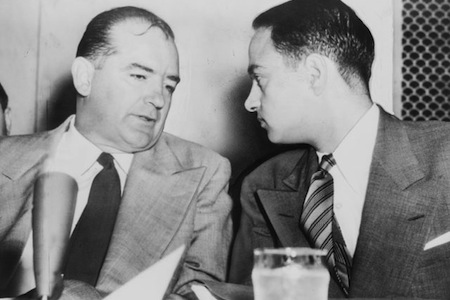Return of the Paranoid Style

Joseph McCarthy with Roy Cohn, 1954. Credit: Library of Congress/New York World-Telegram/Wikimedia Commons.
The Bureau of Labor statistics just announced that unemployment has dropped below 8 percent, the lowest since Barack Obama entered the Oval Office. The new numbers proffer a timely boon to the Obama campaign. For some, however, it appears too timely.
Romney supporters are already claiming that the Obama administration somehow fabricated the statistics for political gain, that nobody “is immune to being bent by Obama and the Democrats.” Jack Welch, former CEO of General Electric, immediately alleged that the Obama camp manipulated the numbers, while at the same time admitting there was “no evidence to prove that.”
All this despite the fact that the Bureau of Labor is insulated from the Obama White House.
This conspiracy theory is gaining momentum, and doubtless will remain with us at least until the November elections.
Conspiracy theories have of course trailed Obama ever since his 2008 presidential run, with plenty on the far right believing him to be some amorphous combination of radical Muslim, Maoist, socialist, and communist.
And let’s not forget the birther movement. You know, those many thousands of Americans who believe Obama really to be an illegal alien, a foreign agent who connived his way into the country’s highest political office by way of a lifelong scheme hatched while within his mother’s womb.
Now before we lump all such theories into any particular side of the political aisle, it is worth remembering that conspiracy theories are a bipartisan American pastime.
In his classic 1964 Harper’s article, historian Richard Hofstadter termed this conspiratorial preoccupation the “paranoid style in American politics.” Hofstadter suggested that more rational minds tend to understand that history is largely “a comedy of errors and a museum of incompetence.” Occam’s razor as applied to history, if you will. The conspiracy theorist alternatively substitutes for every act of incompetence “an act of treason.”
As illustrations, Hofstadter pointed to theories stemming from the anti-communist John Birch Society and McCarthy-era witch hunts of the 1950s; to Gilded Age populist allegations of an Anglo-American banking cabal secretly controlling monetary policy; to nineteenth-century beliefs in Catholic plots to undermine republican values; and to the antebellum Anti-Masonic movement, which would go on to become the first ever national third party in U.S. history.
Hofstadter could easily have pointed instead to the prolific late nineteenth-century charges coming out of the Republican Party, that era’s party of protectionism and big government. In particular, Republican economic nationalists believed that American free traders were secretly conniving with British manufacturers in order to undermine American “infant” industries. Such conspiratorial speculation reached new heights under the Democratic presidencies of Grover Cleveland (1885-89, 1893-97). Owing to Cleveland’s free-trade proclivities, in 1888 the Republican-controlled Senate Foreign Relations Committee even concluded that “the President of the United States may be under influence of foreign and adverse interests.”
Or Hofstadter might instead have pointed to the U.S. Senate’s Nye Committee of the mid-1930s, which alleged that the American munitions and banking industries -- the “merchants of death” -- had colluded with Woodrow Wilson to force the United States into the First World War.
Bigger yet, Hofstadter could have cited the “mother of all conspiracies”: that FDR could somehow have averted the Japanese attack on Pearl Harbor, but purposefully chose not to so as to embroil the U.S. in World War II.
Throw in the JFK assassination, the Gulf of Tonkin, the 9-11 truthers, and so on and so forth. The list of conspiracy theories in American history appears endless.
Ruminating in the wake of McCarthy’s “communist” purges of the State Department, Hofstadter rather understandably considered this paranoid style the primary realm of “the contemporary right wing.”
But the American right by no means has a monopoly on conspiracy theories.
Many on the left, for instance, still cling to the unsubstantiated theory that the Iraq War was secretly a push to obtain Middle Eastern oil.
Furthermore, more than a few on the left and the right subscribe to the idea that global institutions -- from the nascent Trans-Pacific Partnership to the ineffectual United Nations -- are hell-bent on creating some totalitarian New World Order.
And the far left and far right both commonly believe that the so-called mainstream media, or MSM, is invariably “in” on whatever nefarious plot they think is currently being concocted.
Americans love their conspiracies.
But why?
In the mid-1960s, Hofstadter suggested that this paranoia stemmed from a feeling of dispossession among the theorists: that America as they once knew it had been stolen from them.
If anything, this feeling of dispossession is stronger now than ever before, and we hear this forlorn cry from Occupy, the Tea Party, and everywhere in between.
Hofstadter hypothesized “that a mentality disposed to see the world in this way may be a persistent psychic phenomenon, more or less constantly affecting a modest minority of the population.” But he also granted that such modest minorities can mobilize into mass political movements. This situation worsens when these groups “are shut out of the political process.”
Judging by the mass movements on both ends of the political spectrum over the past couple of years alone, such alienation from the political process appears to be reaching a bipartisan breaking point.
As a result, it has become socially acceptable that something as mundane as unemployment statistics now not only provides political ammunition for Glenn Beck’s proverbial chalkboard, but also sends conspiratorial spasms down the very limbs of the American body politic.
Hofstadter’s paranoid style has indeed returned to American politics. But reason can still recover some of its lost ground -- alongside the national employment rate.
